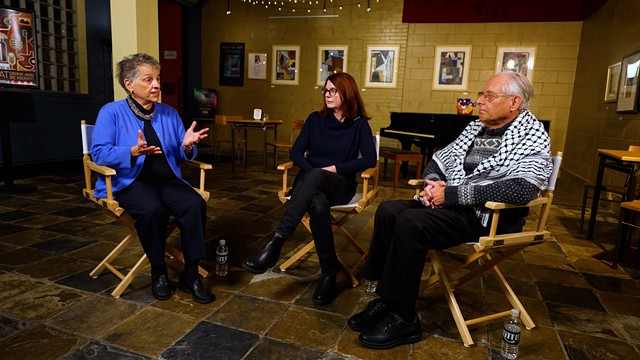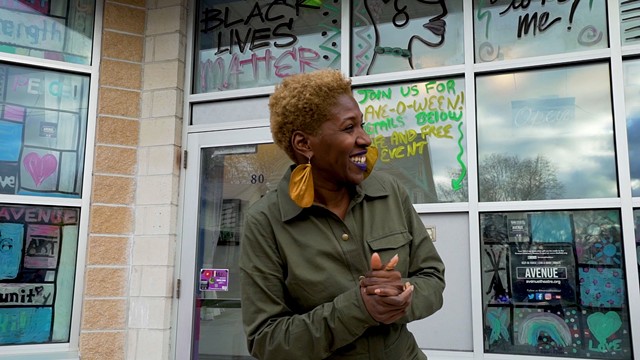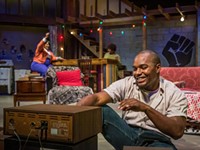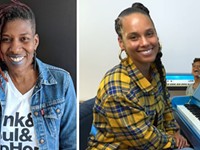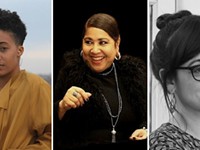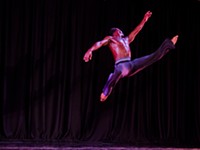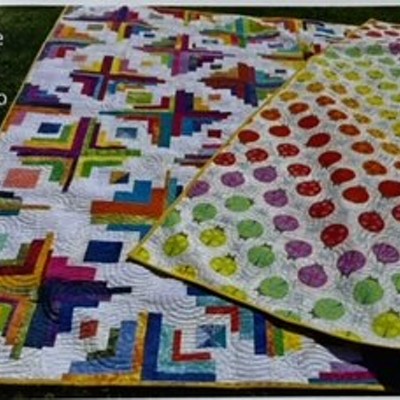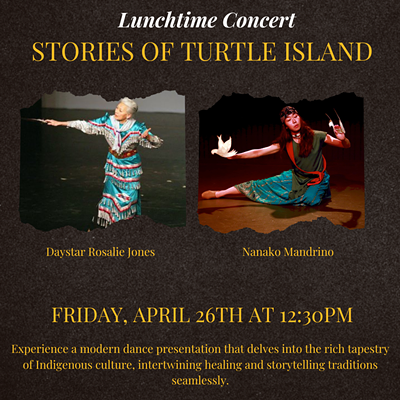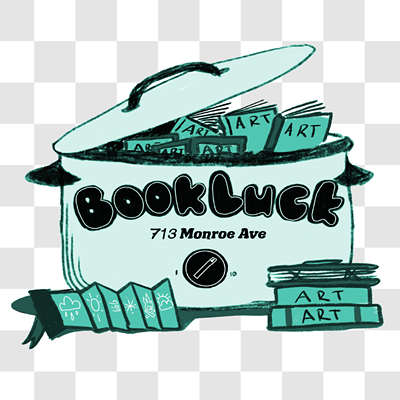[
{
"name": "500x250 Ad",
"insertPoint": "5",
"component": "15667920",
"parentWrapperClass": "",
"requiredCountToDisplay": "1"
}
]
Year to year, Rochester’s arts calendar is packed with gallery exhibitions, film festivals, concerts in every genre of music, and diverse seasons of theatrical performances by professional and community companies.
But even the most ardent patron of the arts can be oblivious to what it took to bring the art to the fore and the people behind the curtain.
“It’s very much that duck above the water that seems all calm and tranquil, but under the water there’s all this kicking around, splashing,” Linda Moroney, the festival director for the four-day One Take Film Festival, says of curating.
Moroney is one of more than a dozen curators — people who form the bridges between artists and audiences — who sat for interviews about what they do for the second season of CITY’s art/WORK series. The series is now available to stream at artworkroc.com.
So, what does being a curator entail? The title brings to mind someone who strolls the hallowed halls of the academic ivory tower, removed from everyday people, hand-selecting cultural artifacts thought to represent them at one time or another.
But the reality of the role today is much more immersed in personal artistic passion as well as consideration for the audiences that curators share this passion with.
“My life really revolves around film,” says Moroney, who is also a co-founder of the Rochester Teen Film Festival and screens documentaries monthly at The Little Theatre. “It’s kind of our family store, it’s what we discuss around the dinner table every evening with our kids — shot composition, sound, music. You can’t just have an opinion if it’s good or bad, you need to be able to come to the table and back up your reasoning.”
Yes, curators have the privilege of choosing what paintings, theatrical productions, films, and musicians to present to audiences. But that comes with administrative and logistical headaches.
They secure the legal rights to plays or films and insurance to protect artwork and performers. They book flights and hotels for visiting artists and filmmakers. They organize artist talkbacks and other events. They write programs. They make sure artists get paid. They have been known to shovel snow from the walkways before performances.
Then, of course, there is the mad hustle to get audiences to show and the daunting responsibility of convincing them why they should care.
Sure, art entertains. But it can also be an entry point to productive conversations about social and political matters. It can give voice to people and entire communities that have been disregarded as the “other.” It can bring adversaries to the same table.
“Witness Palestine’s goal is to describe the human rights abuses in Israel-Palestine,” says Jim Tiefenthal, co-founder of the Witness Palestine Film Festival, which since 2012 has screened four to six documentary and narrative films each October.
Tiefenthal has no background in cinema and fell into the role of being a curator from a sense of urgency to disseminate information about what he felt was an under-examined side of a conflict.
Some curators followed an academic path to their career. Among them is the archivist and curator of media arts at the Memorial Art Gallery, Almudena Escobar López, who is a doctoral candidate in the Visual and Culture Studies program at the University of Rochester.
In her work, López focuses on showcasing video art that strives to tell a more complete picture of human identity and experience than other types of exhibits. She was responsible for the MAG’s 2019 presentation of the video installation “Giverny I (NÉGRESSE IMPÉRIALE)” by Ja’Tovia Gary, in which the artist explored belonging and safety for Black people in America.
Many curators squeaked into their role because of a need in a particular area.
Reenah Golden, founder and artistic director of The Avenue Blackbox Theatre, says she opened the theater in 2018 to create a venue that emphasizes the intersection of Black culture and queer identity, but also one that engages the Joseph Avenue neighborhood and its children.
“It’s really a space where we are cultivating community using the arts and culture,” Golden says. “Our main mission here is to create space for the often marginalized voices that come from those communities.”
Crystal Smith, the founder and producer of the streamable performance and talk show, Rap Rhythm & News, created the show in November 2021 after noticing the dearth of places where young hip-hop and R&B artists in the region could perform.
“The Rochester area has a hard time booking these types of acts,” she says, alluding to the largely unspoken, but in some cases loud, prejudice against rap shows that stems from a few scattered incidents of violence.
Tom DeBlase, co-founder of “Sole Rehab,” works with a variety of venues to host underground queer dance parties. He says he wanted to give emerging house and techno DJs a way to reach audiences, but also emphasized creating a space for people who identify as queer to express themselves together.
“It’s obviously about music, but it’s also about the space,” DeBlase says. “I use that term, ‘safe spaces,’ a lot. That's something that I'm really honored and proud to curate.”
He says the feedback he’s received — “This is the first time I danced with somebody of the same sex” and “This is the first time I wore something that made me feel sexy” — is what keeps him producing these events.
“Getting to be part of that personal experience of growth,” he says, “there’s nothing better than that.”
Rebecca Rafferty is CITY's life editor. She can be reached at [email protected].
But even the most ardent patron of the arts can be oblivious to what it took to bring the art to the fore and the people behind the curtain.
“It’s very much that duck above the water that seems all calm and tranquil, but under the water there’s all this kicking around, splashing,” Linda Moroney, the festival director for the four-day One Take Film Festival, says of curating.
Moroney is one of more than a dozen curators — people who form the bridges between artists and audiences — who sat for interviews about what they do for the second season of CITY’s art/WORK series. The series is now available to stream at artworkroc.com.
So, what does being a curator entail? The title brings to mind someone who strolls the hallowed halls of the academic ivory tower, removed from everyday people, hand-selecting cultural artifacts thought to represent them at one time or another.
But the reality of the role today is much more immersed in personal artistic passion as well as consideration for the audiences that curators share this passion with.
“My life really revolves around film,” says Moroney, who is also a co-founder of the Rochester Teen Film Festival and screens documentaries monthly at The Little Theatre. “It’s kind of our family store, it’s what we discuss around the dinner table every evening with our kids — shot composition, sound, music. You can’t just have an opinion if it’s good or bad, you need to be able to come to the table and back up your reasoning.”
Yes, curators have the privilege of choosing what paintings, theatrical productions, films, and musicians to present to audiences. But that comes with administrative and logistical headaches.
They secure the legal rights to plays or films and insurance to protect artwork and performers. They book flights and hotels for visiting artists and filmmakers. They organize artist talkbacks and other events. They write programs. They make sure artists get paid. They have been known to shovel snow from the walkways before performances.
Then, of course, there is the mad hustle to get audiences to show and the daunting responsibility of convincing them why they should care.
Sure, art entertains. But it can also be an entry point to productive conversations about social and political matters. It can give voice to people and entire communities that have been disregarded as the “other.” It can bring adversaries to the same table.
“Witness Palestine’s goal is to describe the human rights abuses in Israel-Palestine,” says Jim Tiefenthal, co-founder of the Witness Palestine Film Festival, which since 2012 has screened four to six documentary and narrative films each October.
Tiefenthal has no background in cinema and fell into the role of being a curator from a sense of urgency to disseminate information about what he felt was an under-examined side of a conflict.
Some curators followed an academic path to their career. Among them is the archivist and curator of media arts at the Memorial Art Gallery, Almudena Escobar López, who is a doctoral candidate in the Visual and Culture Studies program at the University of Rochester.
In her work, López focuses on showcasing video art that strives to tell a more complete picture of human identity and experience than other types of exhibits. She was responsible for the MAG’s 2019 presentation of the video installation “Giverny I (NÉGRESSE IMPÉRIALE)” by Ja’Tovia Gary, in which the artist explored belonging and safety for Black people in America.
Many curators squeaked into their role because of a need in a particular area.
Reenah Golden, founder and artistic director of The Avenue Blackbox Theatre, says she opened the theater in 2018 to create a venue that emphasizes the intersection of Black culture and queer identity, but also one that engages the Joseph Avenue neighborhood and its children.
“It’s really a space where we are cultivating community using the arts and culture,” Golden says. “Our main mission here is to create space for the often marginalized voices that come from those communities.”
Crystal Smith, the founder and producer of the streamable performance and talk show, Rap Rhythm & News, created the show in November 2021 after noticing the dearth of places where young hip-hop and R&B artists in the region could perform.
“The Rochester area has a hard time booking these types of acts,” she says, alluding to the largely unspoken, but in some cases loud, prejudice against rap shows that stems from a few scattered incidents of violence.
Tom DeBlase, co-founder of “Sole Rehab,” works with a variety of venues to host underground queer dance parties. He says he wanted to give emerging house and techno DJs a way to reach audiences, but also emphasized creating a space for people who identify as queer to express themselves together.
“It’s obviously about music, but it’s also about the space,” DeBlase says. “I use that term, ‘safe spaces,’ a lot. That's something that I'm really honored and proud to curate.”
He says the feedback he’s received — “This is the first time I danced with somebody of the same sex” and “This is the first time I wore something that made me feel sexy” — is what keeps him producing these events.
“Getting to be part of that personal experience of growth,” he says, “there’s nothing better than that.”
Rebecca Rafferty is CITY's life editor. She can be reached at [email protected].
Speaking of...
Latest in Art
More by Rebecca Rafferty
-

Beyond folklore
Apr 4, 2024 -

Partnership perks: Public Provisions @ Flour City Bread
Feb 24, 2024 -

Raison d’Art
Feb 19, 2024 - More »

